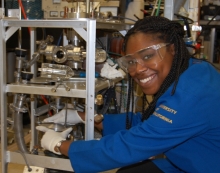
Major:
University:
Mentor(s):
Faculty Sponsor(s):
Faculty Sponsor's Department(s):
Project Title:
Project Description:
The phenomenon of investigating biomolecular building block properties as individual, isolated molecules in the gas phase was first recorded in the early 1960s. In the 1980s, laser desorption and jet cooling were combined to study the cold biomolecules in their gas state. Dynamic electronic and geometric properties can be investigated through laser spectroscopy and mass spectrometry by way of laser desorption jet-cooling, resonant two-photon ionization, and high resolution time of flight-mass spec. Currently, laser desorption and mass spectrometry are used for qualitative analysis of organic biomarkers in archeological vessels. For example, methyl xanthines — caffeine, theobromine, and theophylline — are tracer compounds for identifying remnants of cacao and tea in ancient pottery. Research is now focused on investigating wine consumption patterns in ancient Egypt and Nubia, through analysis of beverage containing vessels collected from ancient feasting sites of Askut and Tombos. Vanillic acid and syringic acid are used as trace markers for identifying peonidin in grape wine and malvidin in red wine, respectively. Additionally, resveratrol, found in grapes and red wine, served as a positive indicator. For analysis, samples of the vessels were either applied to a graphite sample bar directly or dropcast from extract. Samples were then desorbed by laser desorption into a jet cooled molecular beam and carried to the source, followed by resonant laser excitation and ionization and detected by time-of-flight mass spectrometry. Previously collected high resolution UV spectrum of vanillic acid, syringic acid, and resveratrol were used to positively identify wine in the composition of archeological vessels.
